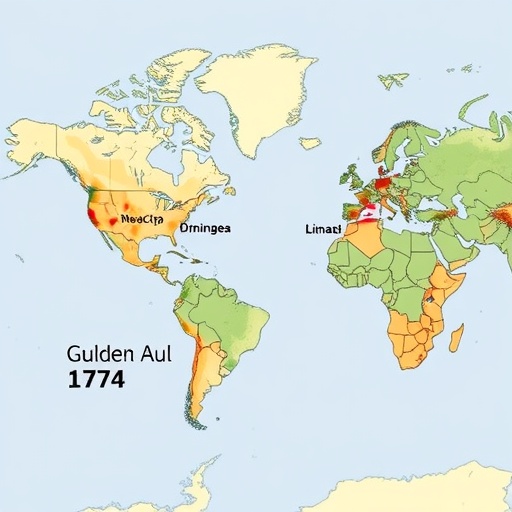As climate change continues to reshape ecosystems worldwide, the intricate timing of biological processes in many species faces unprecedented challenges. New research emerging from Case Western Reserve University uncovers a subtle yet profound disruption in the winter preparation strategies of gray tree frogs (Hyla versicolor), revealing how these amphibians’ reliance on photoperiod — the length of daylight — rather than actual temperature, may place them at risk in the warming climate of Ohio and beyond.
Gray tree frogs possess a remarkable adaptation that allows them to endure the brutal winter months: they survive freezing conditions by effectively turning into living antifreeze systems. Their bodies accumulate cryoprotectants — biochemical compounds such as glycerol — which prevent ice crystal formation inside cells, thereby safeguarding vital tissues from freeze damage. This metabolic feat hinges on their ability to store glycogen in their livers, which later transforms into glycerol as temperatures drop.
Traditionally, the progression into this state of cold hardiness aligns closely with seasonal environmental cues. However, the latest study reveals a significant decoupling between these cues due to climate change-driven shifts in temperature patterns. Although day length continues to shorten predictably in autumn, the ambient temperatures in Ohio winters have become progressively milder over recent decades. This mismatch means gray tree frogs may initiate costly physiological preparations for winter too early, leading to an unwarranted allocation of energy toward cryoprotectant accumulation when it may not yet be necessary.
The researchers examined this phenomenon by subjecting tadpoles and juvenile frogs to controlled variations of daylight duration while maintaining a constant ambient temperature. Three photoperiod regimes were simulated: increasing day length mimicking spring conditions, unaltered day lengths simulating summer, and decreasing day length characteristic of fall. Strikingly, frogs exposed to shortened day lengths — even at warm temperatures unsuitable for freezing — increased their liver glycogen storage up to 14 times the amount seen in other groups. Correspondingly, the liver size expanded three to fourfold.
This enhanced glycogen storage, however, came at a significant cost. Frogs preparing prematurely for winter exhibited stunted growth and smaller overall body size. The biochemical resources were diverted from muscle and bone development toward cryoprotectant synthesis, constraining their growth potential. This energetic trade-off underscores the potential fitness consequences of mistimed physiological adaptations to environmental cues.
Such maladaptive responses typify what scientists term an “ecological trap.” Previously reliable signals, like day length, become misleading in the context of rapid environmental change, prompting organisms to act in ways detrimental to their survival and reproduction. For gray tree frogs, this trap involves premature winter hardening, which may suppress their development and impair fitness, making the species vulnerable to the cascading impacts of climate variability.
While current population assessments of Hyla versicolor do not indicate drastic declines, concerns grow that similar physiological mismatches may imperil more geographically restricted or less flexible species. The ecological repercussions extend beyond individual species: altered breeding cycles, disrupted migration patterns, and shifts in community dynamics could emerge as phenological cues become increasingly unreliable under climate change.
The study leverages a unique interdisciplinary research framework involving Case Western Reserve University, the Cleveland Metroparks Zoo, and the Holden Arboretum. Researchers employed innovative methodologies, combining field manipulations with laboratory precision. Outdoor pools housing tadpoles were systematically shaded and exposed to simulate natural shifts in photoperiod, followed by lab-based monitoring of glycogen levels within frog livers using veterinary health assessment techniques adapted for wildlife.
This integrative approach exemplifies how collaborative scientific efforts can elucidate complex ecological phenomena with real-world conservation implications. The findings serve as a clarion call for deeper investigations into how photoperiod-dependent physiology interacts with changing thermal environments, affecting species persistence in temperate ecosystems.
Beyond its biological insights, this work highlights the need to reconsider traditional models that assume environmental cues operate harmoniously in nature. As climate warming alters the historic rhythm of temperature and light cycles, species relying rigidly on photoperiodic signals may increasingly misalign their life-history events. This research, published in the Journal of Animal Ecology, paves the way for more nuanced strategies in wildlife management and conservation planning that accommodate the hybrid impacts of climate variables.
The future trajectory of species like the gray tree frog exemplifies broader ecological vulnerabilities induced by climate change. Understanding the mechanistic underpinnings of phenological shifts — how and why organisms respond to environmental signals — will be fundamental to forecasting biological outcomes and mitigating adverse effects on biodiversity. These insights extend beyond amphibians, offering paradigmatic lessons applicable to myriad taxa exhibiting seasonal physiological plasticity.
Ultimately, studies such as this reveal the delicate balance organisms maintain with their environments—and how climate change threatens to unravel these evolutionary adaptations. Addressing these challenges demands cross-disciplinary research integrating physiology, ecology, and climate science to develop comprehensive conservation frameworks protecting vulnerable species as Earth’s climate continues to transform.
Subject of Research:
Gray tree frogs’ physiological responses to photoperiod cues in relation to climate change-induced temperature shifts.
Article Title:
Freeze-tolerant frogs accumulate cryoprotectants using photoperiod: A potential ecological trap
Web References:
Case Western Reserve University: http://case.edu/
Journal of Animal Ecology DOI: http://dx.doi.org/10.1111/1365-2656.70125
Image Credits:
Troy Neptune / Case Western Reserve University
Keywords:
Animal ecology, Climate change, Climate change effects, Frogs, Animal physiology




